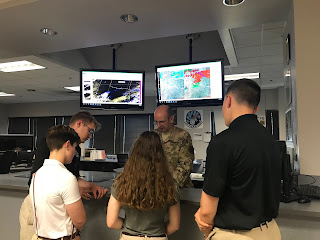We started out day 14 of our trip in Guthrie, OK. The weather looked somewhat promising in the northwest corner of Kansas, but considering the storms weren't going to fire until late, it would have been too difficult to travel there and back since two of our cadets had 0500 flights the following morning in OKC. Instead of following the storms, we stayed put in Oklahoma City for the day and went to a small community pool. We met up as a team one final time that night for ice cream. Major Nixon had lost a previous bet to CDT Pengelley, and as a result, had to buy Pengelly's monstrous ice cream cone.
The following morning, we woke up to a flash flood warning and a heavy line of thunderstorms moving into the city. The view outside the hotel room of the shelf cloud rolling in was incredible! We made one last trek to the airport where we all went our separate ways.
All-in-all, this was a successful trip. We got great information from the various bases we visited and were also able to observe numerous weather phenomenon including two tornadoes, gustnadoes, a developing haboob, supercells, hail, shelf clouds, etc. Plus, criss-crossing the country, seeing the culture, and eating the local food was an unexpected bonus. In all, we drove 5519 miles and visited five different states, missing New Mexico and Missouri by only a few miles.
 |
| Approaching shelf cloud over Oklahoma City. Not a bad view from the hotel room! |
 |
| CDT Pengelly enjoys his ice cream, much to the chagrin of Maj. Nixon who had to pay. |























































